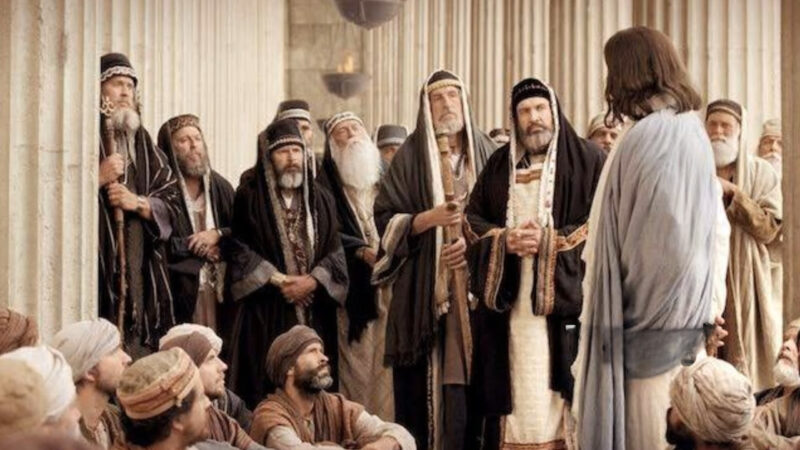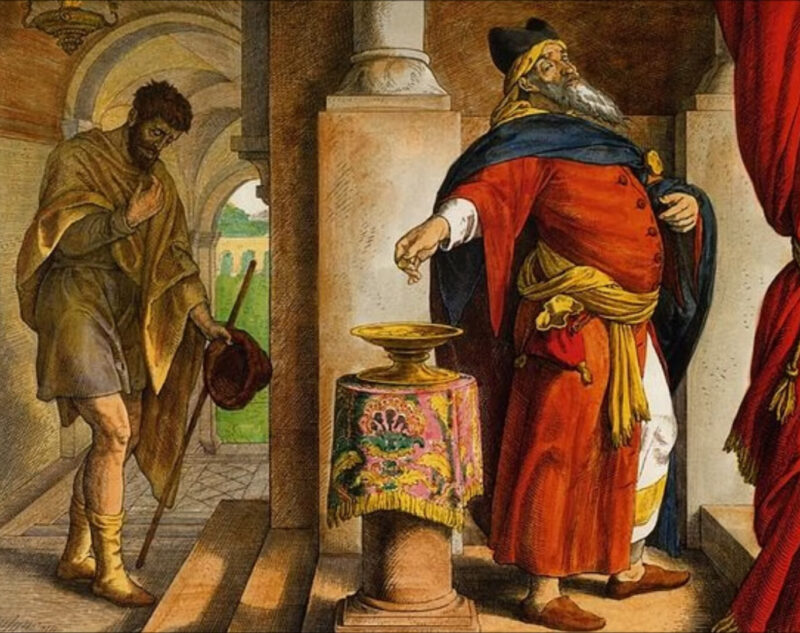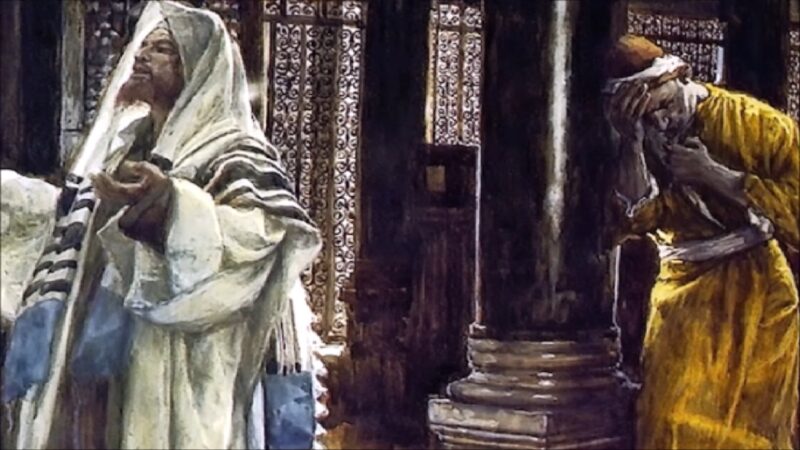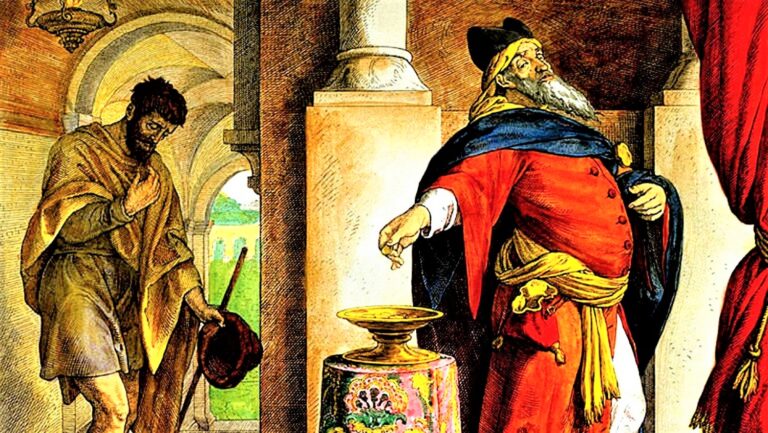The parable of the Pharisee and the Tax Collector is one of the most potent narratives delivered by Jesus, found in the Gospel of Luke. It masterfully underscores the difference between genuine humility and self-righteous pride.
The tale presents two characters that stand in stark contrast in terms of their spiritual posture and approach to God. Today, we will discuss the intricacies of their characters, the deeper meaning of the parable, and its enduring relevance to modern times.
The Cultural Background
The Jewish Context in the First Century

The world Jesus inhabited was steeped in Judaic traditions, customs, and societal norms. During the 1st century in Palestine, Pharisees were the religious elites, revered and respected for their stringent adherence to Jewish law.
They were the epitome of devout living, meticulously observing rituals and setting an example for the masses. On the other hand, tax collectors were often despised. Seen as collaborators with the Roman Empire, they were regarded as traitors who extorted their own people.
To many, they represented the oppressive force of Rome and were routinely classified as sinners due to their perceived dishonesty.
Their Roles and Significance

The Pharisees weren’t just religious figures; they were also scholars and interpreters of the Torah. They were the gatekeepers of orthodoxy, ensuring that the Jewish community adhered to the laws and traditions passed down through generations.
Conversely, tax collectors, or ‘publicans,’ were typically Jews who worked for the Roman Empire. Their main role was to collect taxes from the Jewish populace. Due to the corrupt nature of the tax system, many tax collectors were known to demand more than what was due, pocketing the excess for themselves.
The Parable
The Pharisee’s Prayer
Jesus sets the scene in the temple where both men have come to pray. The Pharisee stands confidently, thanking God that he isn’t like other men, especially not like the tax collector. He touts his fasting and tithing practices, essentially bragging about his religious observances.
This reveals a critical flaw in his character – pride. The Pharisee isn’t genuinely communicating with God but is rather showcasing his supposed righteousness. His prayer lacks humility, showcasing an attitude that believes he has earned favor with God based on his works.
The Tax Collector’s Plea
The tax collector, standing at a distance, doesn’t even lift his eyes to heaven. He beats his chest in a sign of repentance and simply says, “God, be merciful to me, a sinner.” Unlike the Pharisee, the tax collector acknowledges his shortcomings and his utter dependence on God’s mercy.
His prayer is a stark contrast to that of the Pharisee. While the Pharisee is self-congratulatory, the tax collector is deeply introspective and aware of his unworthiness. It’s a sincere cry from a contrite heart.
The Core Message and its Modern Relevance

Judgment and Justification
Jesus concludes the parable by saying that the tax collector went home justified before God, while the Pharisee did not. It wasn’t the Pharisee’s acts of righteousness that were the issue, but rather his self-righteous attitude.
He looked down on others and exalted himself. The message is clear: God opposes the proud but gives grace to the humble. The parable highlights that righteousness is not about external acts but about the posture of one’s heart. True justification comes from recognizing one’s sins and relying on God’s mercy.
Applying the Lesson Today
The parable isn’t just a historical account but holds significant relevance in today’s world. Many fall into the trap of the Pharisee, basing their worth or religious standing on external achievements, societal status, or perceived moral superiority over others.
In the age of social media, it’s easy to ‘showcase’ our righteousness or look down upon others. The parable is a timeless reminder to introspect, acknowledge our flaws, and approach God (and others) with genuine humility. It urges us to evaluate the motivations behind our actions and to be wary of self-righteousness.
The Symbols and Nuances

The Temple Setting
The choice of the temple as the backdrop for this parable is deliberate and brimming with symbolism. The temple, in Jewish tradition, represented God’s dwelling place on earth.
By placing the Pharisee and the Tax Collector within this sacred setting, Jesus underscores the universal human quest for connection with the Divine. However, while both men are physically in the same location, their spiritual positions are worlds apart.
The Pharisee stands prominently, perhaps in a place of honor, while the Tax Collector lingers at the back, showcasing his sense of unworthiness. This juxtaposition highlights that one’s physical positioning or stature doesn’t necessarily correlate with one’s spiritual standing with God.
Physical Gestures as Windows to the Soul
The actions of both characters offer profound insights into their internal states. The Pharisee stands tall, probably with his arms raised in the traditional Jewish posture of prayer.
This stance, while customary, also reveals his self-assuredness and arrogance in this context. The Tax Collector’s gestures, however, tell a tale of deep remorse and humility. Beating one’s chest was a cultural sign of grief and repentance.
By not even lifting his eyes to heaven, he visually expresses his feelings of shame and contrition. His actions are not for show; they are raw, genuine manifestations of his internal anguish and plea for mercy.
The Enduring Challenge: Self-Reflection and Growth
The Danger of Complacency
One of the subtle warnings in the parable is about the peril of spiritual complacency. The Pharisee, due to his elevated societal and religious status, might have felt he had “arrived” spiritually. His prayer is more of a monologue, listing his achievements rather than seeking growth or connection with God.
On the other hand, the Tax Collector’s plea showcases a heart that yearns for transformation. His acknowledgment of his sin is the first step toward genuine change. Recognizing our flaws, regardless of where we are on our spiritual journey, is essential for continued growth and deepening our relationship with the Divine.
A Call to Authenticity
Beyond the evident lessons on humility and pride, the parable also champions the cause of authenticity. In an era where appearances often mattered more than genuine piety, Jesus highlights the value of sincerity. You should also read the interesting story where baby Jesus was gifted with gold.
Today, in a world dominated by curated online personas and the pressure to project perfection, the call to be genuine in our spiritual and personal lives is even more pressing.
FAQs
Why did Jesus often use parables to convey His messages?
Jesus utilized parables as a teaching tool because they effectively conveyed profound spiritual truths through simple, relatable stories. Parables captivate the listener’s attention, evoke introspection, and allow for multiple layers of interpretation.
They were also culturally relevant, using scenarios and characters familiar to His audience, making the lessons memorable and impactful.
Were all tax collectors in that era considered dishonest?
Not every tax collector was dishonest, but the profession had a notorious reputation due to the widespread corruption within its ranks. The Roman tax system permitted tax collectors to exact more than the official rate, allowing them to pocket the excess.
This practice, combined with their collaboration with the Roman oppressors, contributed to the general disdain towards them.
How did the general public during Jesus’ time react to this parable?
The exact reactions of all listeners are not detailed in the scriptures, but given the cultural context, many would have been surprised by the conclusion of the parable.
The Pharisees were widely regarded as righteous, so presenting a tax collector in a more favorable light would have been a stark departure from societal expectations, challenging the listeners’ preconceived notions about righteousness and humility.
How did the Pharisees typically respond to Jesus’ teachings, especially parables like this?
Many Pharisees took offense to Jesus’ teachings, especially when they felt targeted or criticized. Parables like this one, which contrasted the behavior of a Pharisee with someone they deemed a “sinner,” often led to heightened tensions between Jesus and the Pharisaic community.
While some Pharisees were genuinely curious or even believed in Jesus, many saw Him as a threat to their authority and influence.
Are there any other parables where tax collectors are mentioned or play a significant role?
Yes, tax collectors are mentioned in other parables and narratives within the Gospels. One notable instance is the calling of Levi (Matthew), a tax collector, to be one of Jesus’ disciples. Additionally, in the parable of the two sons in Matthew’s Gospel, tax collectors are contrasted favorably with religious leaders in terms of accepting the message of John the Baptist.
How can this parable be applied in contexts outside of religious or spiritual discussions?
The core messages of humility, self-awareness, and genuine introspection can be applied in various contexts, be it in personal relationships, professional environments, or societal interactions.
The caution against judging others based on their profession or societal status and the emphasis on internal motivations over outward appearances are universal themes that resonate across cultures and belief systems.
Final Words
The parable of the Pharisee and the Tax Collector is a profound lesson on humility, self-awareness, and the dangers of pride. Through the contrasting prayers of these two men, Jesus illustrates that true righteousness is a matter of the heart.
In a world that often values appearance over substance, this age-old lesson serves as a timely reminder of the virtues of humility and genuine self-reflection.







